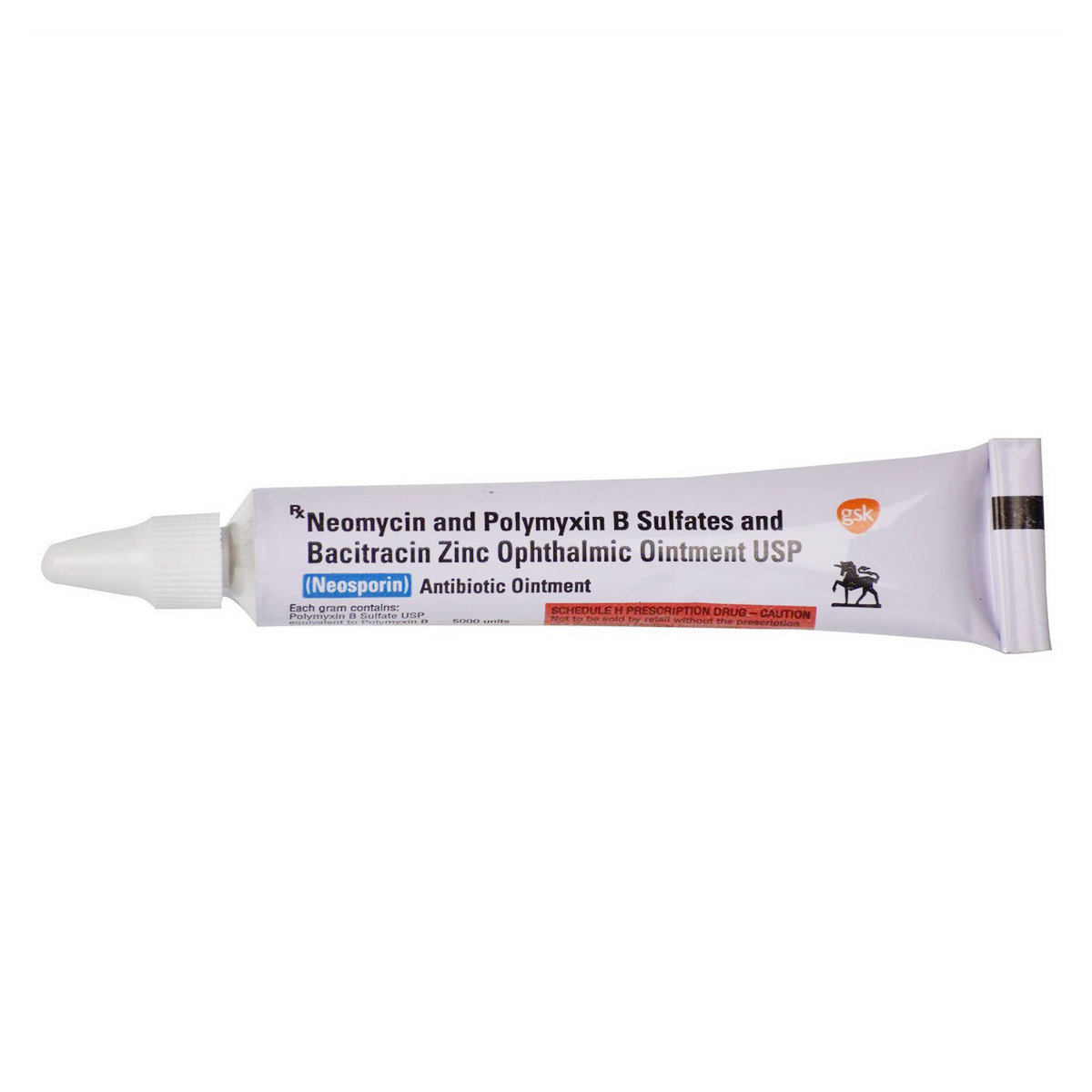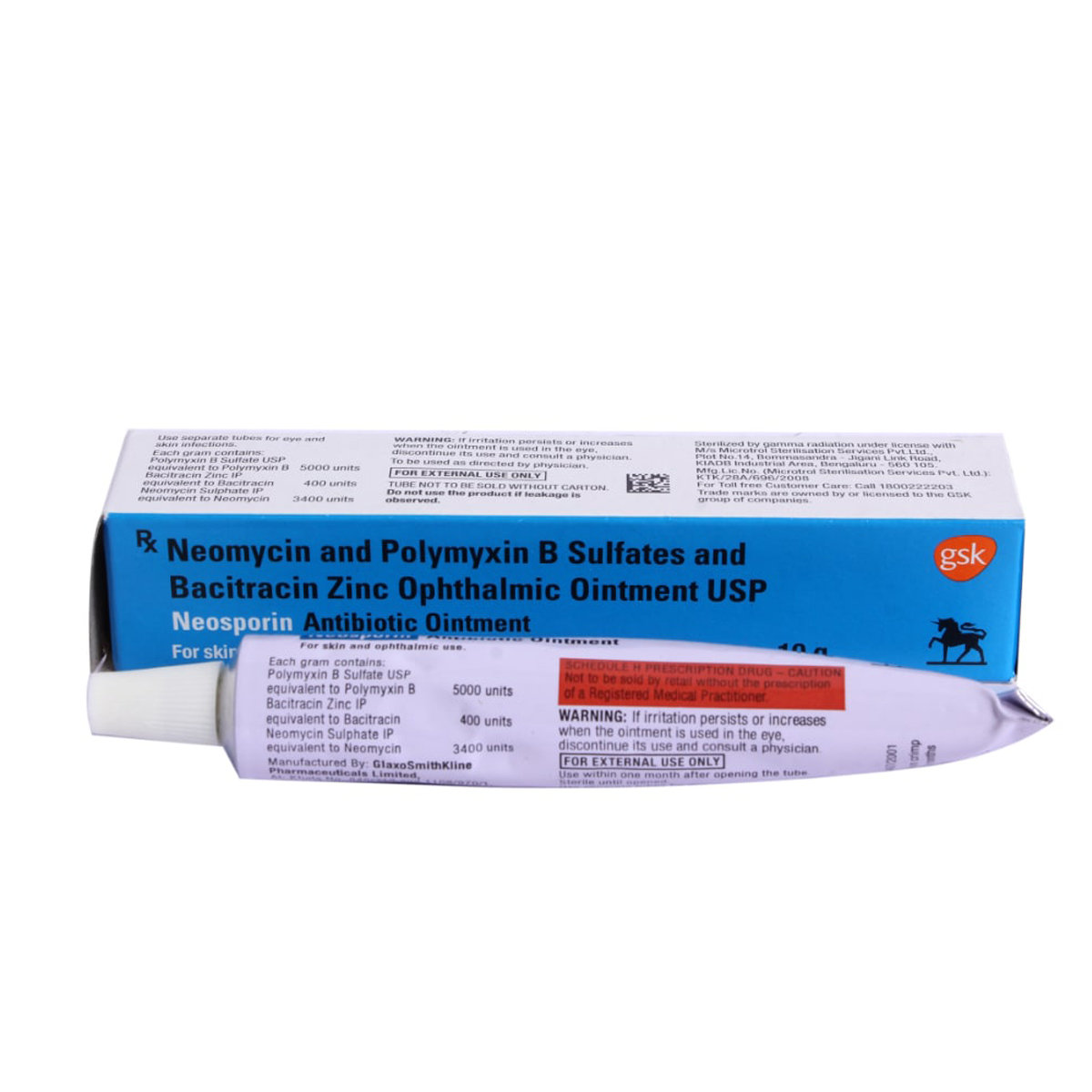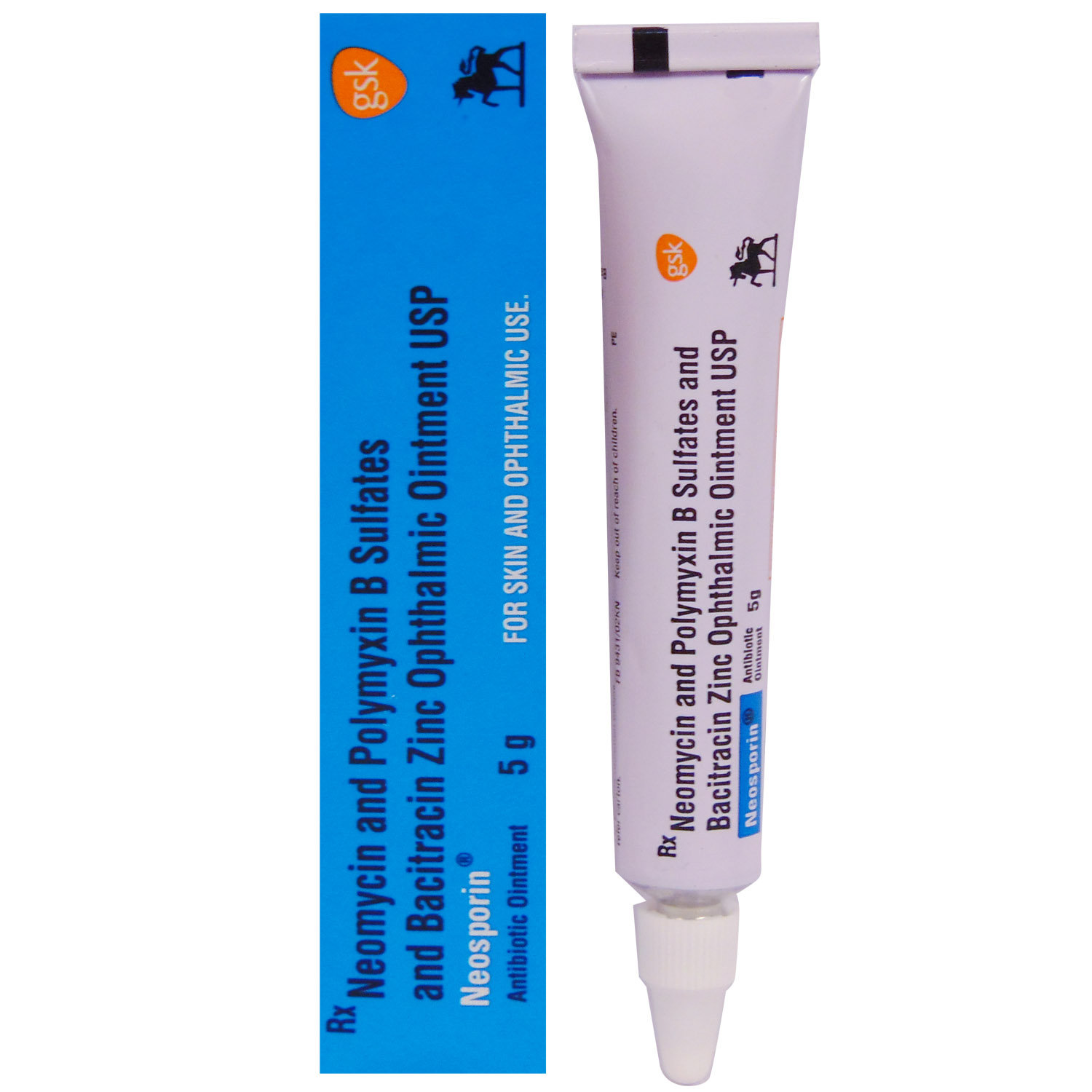Nebazine Ointment 20gm

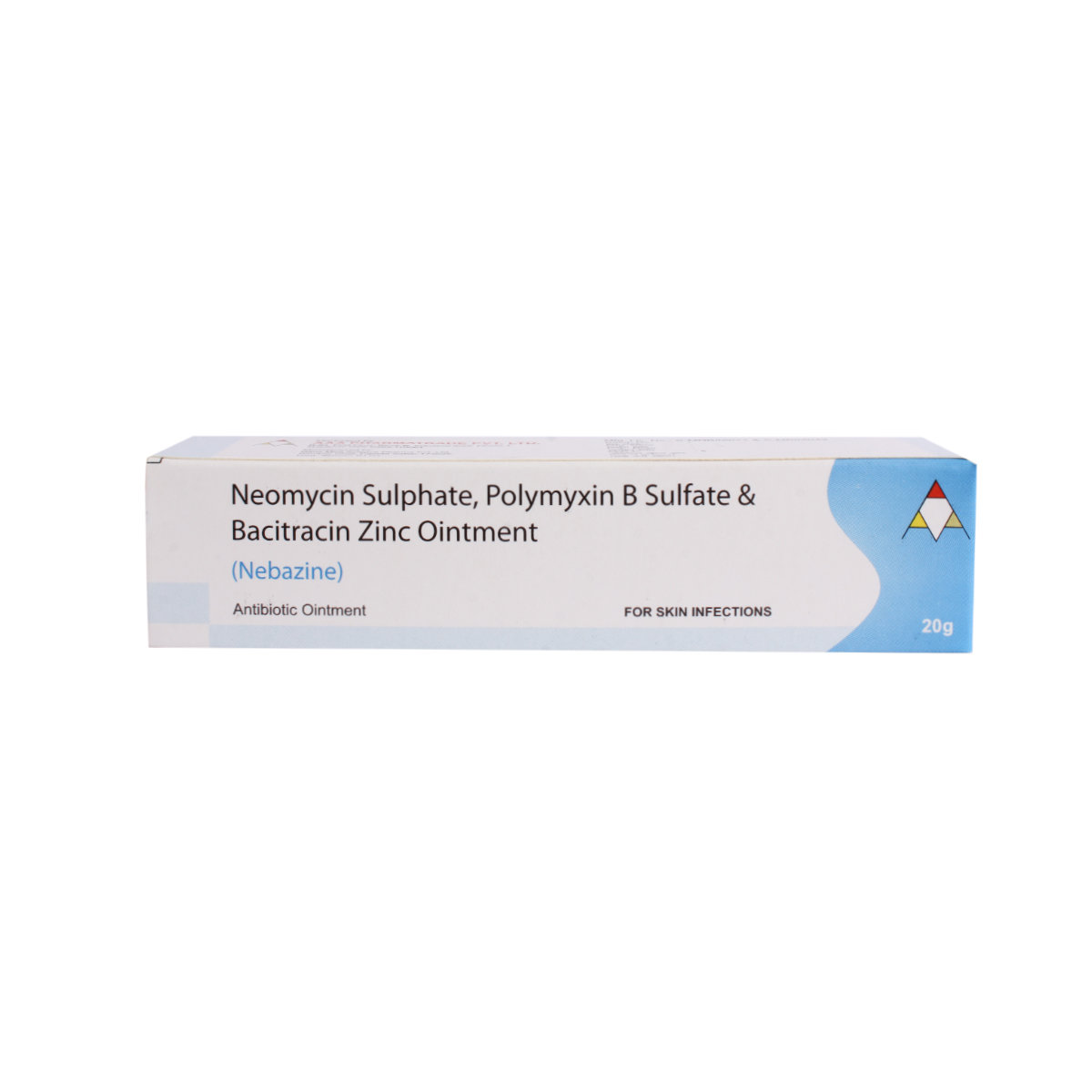
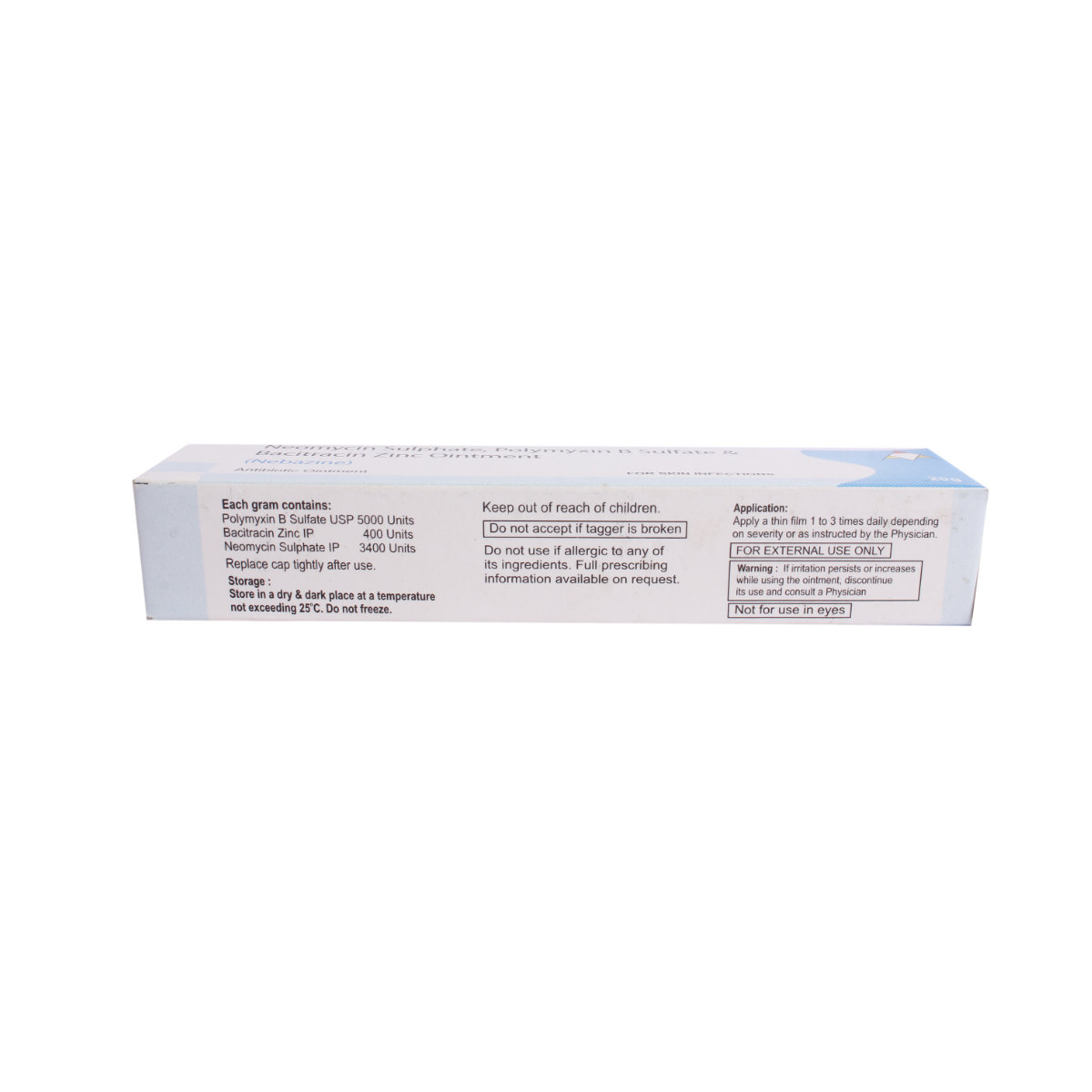

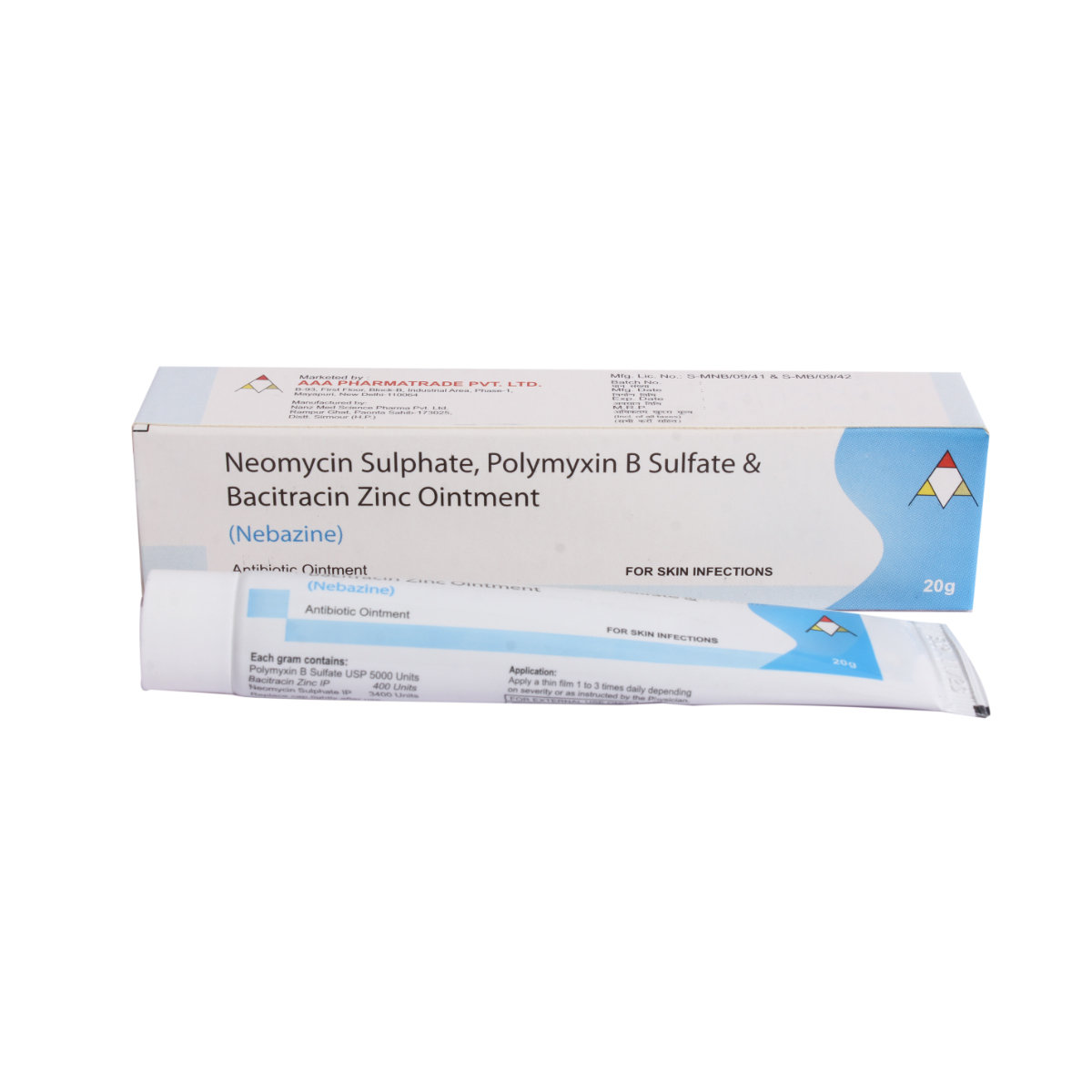


MRP ₹111.5
(Inclusive of all Taxes)
₹11.2 Cashback (10%)
Provide Delivery Location
Online payment accepted
 Prescription drug
Prescription drugWhats That
Composition :
Manufacturer/Marketer :
Consume Type :
Expires on or after :
Return Policy :
About Nebazine Ointment
Nebazine Ointment is a dermatological medication that belongs to the class of 'antibiotics' and is primarily used to treat bacterial skin infections. Nebazine Ointment is used as a first aid antibiotic to prevent infections in minor cuts, scrapes, or burns on the skin. Bacterial skin infection occurs when bacteria penetrate through hair follicles or the broken skin and cause infection.
Nebazine Ointment is composed of three antibiotic medicines: Bacitracin, Neomycin, and Polymyxin B. Bacitracin is a bacteriostatic medicine that works by inhibiting the bacterial cell wall synthesis. Neomycin prevents the synthesis of essential proteins required by bacteria to carry out vital functions. Polymyxin B destroys the bacterial membranes by binding to the phospholipids on cell membranes of gram-negative bacteria. This process of binding causes the loss of essential metabolites in bacteria. Together, Nebazine Ointment treats bacterial skin infections.
Your doctor will advise the appropriate dose that suits your infection. Common side effects of Nebazine Ointment include itching, skin irritation, rash, redness, and swelling at the application site. These side effects may not occur in every patient using this medication and differ individually. If the side effects persist longer or worsen, please seek a doctor's advice.
Inform your doctor if you are sensitive to Nebazine Ointment or other medications. Do not apply Nebazine Ointment on deep puncture wounds, serious burns, deep cuts or an animal bite. Let your doctor know if you have viral or fungal skin infections, chronic ear infections, and ruptured ear drum before using Nebazine Ointment. Pregnant and breastfeeding women should consult their doctor before starting Nebazine Ointment.
Uses of Nebazine Ointment
Directions for Use
Key Benefits
Nebazine Ointment is composed of three antibiotic medicines, namely Bacitracin, Neomycin, and Polymyxin B. Bacitracin is a bacteriostatic medicine (that stops the growth or reproduction of bacteria). It works by inhibiting bacterial cell wall synthesis. Neomycin is an aminoglycoside antibiotic and prevents the synthesis of essential proteins required by bacteria to carry out vital functions. Polymyxin B, an antibiotic, destroys the bacterial membrane by binding to the phospholipids on the cell membranes of gram-negative bacteria. This process of binding causes the loss of essential metabolites in bacteria. Together, Nebazine Ointment treats bacterial skin infections.
Storage
- Skin rash caused by allergies is due to irritants or allergens. Therefore, avoid contact with such irritants.
- Consult your doctor for proper medication and apply an anti-itch medication. Follow the schedule and use the medication whenever needed.
- Protect your skin from extreme heat and try to apply wet compresses.
- Soak in the cool bath, which gives a soothing impact to the affected area.
Drug Warnings
Let your doctor know if you have viral or fungal skin infections, chronic ear infections, and ruptured ear drum before using Nebazine Ointment. Avoid applying Nebazine Ointment on sunburns, lesions, blisters and open wounds. Do not wash the treated areas for a minimum of 3 hours after you apply Nebazine Ointment. Let your doctor know if you plan to become pregnant, are already pregnant or are a lactating mother before using Nebazine Ointment. Use Nebazine Ointment in children more than 2 years only if a doctor recommends it.
Drug-Drug Interactions
Drug-Drug Interactions
Login/Sign Up
Drug-Food Interactions
Drug-Food Interactions
Login/Sign Up
Diet & Lifestyle Advise
- Use mild soap while taking baths and prefer warm baths.
- Always wear loose-fitting clothes to avoid further sweat and spreading skin infection.
- Do not scratch the affected skin area.
- Avoid sharing towels, combs, bedsheets, shoes or socks with others.
- Wash your bed sheets and towels regularly.
- Avoid or limit the intake of alcohol and caffeine.
- Manage stress, eat healthily, drink plenty of water, exercise regularly, and get plenty of sleep.
Side Effects of Nebazine Ointment
- Itching
- Skin irritation
- Rash
- Redness
- Swelling at the application site
Habit Forming
Therapeutic Class
All Substitutes & Brand Comparisons
RX
Out of StockNeosporin Skin Ointment
GlaxoSmithKline Pharmaceuticals Ltd
₹192.5
(₹5.78/ 1gm)
15% COSTLIERRX
Neosporin Skin Ointment 30 gm
GlaxoSmithKline Pharmaceuticals Ltd
₹218
(₹6.54/ 1gm)
30% COSTLIERRX
Neosporin Skin Ointment 15 gm
GlaxoSmithKline Pharmaceuticals Ltd
₹131.5
(₹7.89/ 1gm)
57% COSTLIER
Product Substitutes
Author Details
We provide you with authentic, trustworthy and relevant information
Drug-Diseases Interactions
Drug-Diseases Interactions
Login/Sign Up
FAQs
Nebazine Ointment consists of antibiotic medications, namely: Bacitracin, Neomycin and Polymyxin B. It inhibits bacteria's growth by causing damage to its cell wall and prevents the synthesis of essential proteins required by bacteria to carry out their vital functions.
Nebazine Ointment is not recommended for use in fungal or viral skin infections. It is effective only against bacterial skin infections and minor skin infections caused by small cuts, scrapes, or burns.
Nebazine Ointment is not recommended for use on deep cuts, puncture wounds, animal bites, and serious burns.
Your doctor will decide the dose and duration of Nebazine Ointment based on the severity of your infection. It is advised to use Nebazine Ointment only for the prescribed period since long-term usage may cause weakening and thinning of the skin.
Please do not stop using Nebazine Ointment on your own even if the symptoms are relieved. Your symptoms may improve before the skin infection is completely cured. Continue using Nebazine Ointment until the course advised by the doctor is finished.
Drug-Drug Interactions Checker List
- AMIKACIN
- GENTAMICIN
- TOBRAMYCIN
Special Advise
- It is advised to contact your doctor if the infection symptoms persist or worsen after two weeks of treatment.
- Avoid contact of Nebazine Ointment with nose, mouth or eyes. If Nebazine Ointment accidentally comes in contact with these areas, rinse with water thoroughly.
Disease/Condition Glossary
Bacterial skin infection: Bacterial skin infection occurs when bacteria penetrate through hair follicles or the broken skin breaks and cause infection. Symptoms include redness, pain, and tenderness of the skin, minor bumps or boils, rashes, blisters, cracked/dry skin, swelling, stinging or burning sensation, pus formation, and itching. Bacterial skin infections are generally mild and can be treated using topical antibiotics. Sometimes, for a severe infection, an oral antibiotic may be required. Common bacterial infections include cellulitis (red and swollen skin), erysipelas (large patches on the skin), impetigo (red sores on the face), folliculitis (inflammation of hair follicles), and carbuncles (pus-filled bumps).

Have a query?
Buy best Dermatology products by
Others
AYUR
FIXDERMA
BIODERMA
VENUSIA
CANDID
SELSUN
ABZORB
ATODERM
CIPHANDS
KETO
MINTOP
UVAVO
8X
MELALUMIN
MORR
OILATUM
REJUHAIR
SUNCROS
TETMOSOL
UNISON
UV DOUX
ATBRO SAFEXX
BETADINE
COLOPLAST
DR. MOREPEN
HAIR 4U
LA SCREEN
MEDERMA
RING GUARD
SHYN-ON
SOLSET
SUNSTOP
YUVINIE
A-DERMA
AHD
ALCONANZ
AQUAHOLD
AVARTA
AVENE
BIOLINE
BIOWRIGHT
CETRILAK
CUTICOLOR
CUTILOCK
DANDEL PLUS
DEOPHIN
DOUX
DYSIS
ENMASK 50
EXIZOL
FAIR INSTA
GETRYL
GORGEUS
GUNEERA
HAIR YUTH
HH MITE
I-GLOW
ITCH GUARD
KETOFLY
KETOMAC
KETOPZ
KETOSTAR
KZ
LIPZ
MANKIND
MEDRAYS
MELAGARD
MELNORA BLUV
MICROSTERILE
NO SCARS
OAKNET
ONABET
PARASOFT
PERCOS
PHOTON
PHOTOSTABLE
PHYSIOGEL
PROTEK
RADIBAN
RASHFREE
REGALIZ
RENOCIA
SALISIA
SEBANDRO
SEBORBAR
SESTRY
SOLASAFE
SOLECROSS
STERILLIUM
SUDERMA
SUN KROMA
SUNCLIP
SUNHEAL
SUNMATE
SUNTRIS
TAIYU
TEDIBAR
THERUPTOR
TRICOGRO
Glenmark Pharmaceuticals Ltd
Sun Pharmaceutical Industries Ltd
Klm Laboratories Pvt Ltd
Cipla Ltd
Canixa Life Sciences Pvt Ltd
Abbott India Ltd
Ajanta Pharma Ltd
Intas Pharmaceuticals Ltd
Dr Reddy's Laboratories Ltd
East West Pharma India Pvt Ltd
Alkem Laboratories Ltd
Atopic laboratories Pvt Ltd
Hegde & Hegde Pharmaceutica Llp
Brinton Pharmaceuticals Ltd
Torrent Pharmaceuticals Ltd
Amwill Healthcare Pvt Ltd
Leeford Healthcare Ltd
Palsons Derma Pvt Ltd
Oaknet Healthcare Pvt Ltd
Med Manor Organics Pvt Ltd
Micro Labs Ltd
Dermocare Laboratories Gujarat Llp
Fixderma India Pvt Ltd
Apex Laboratories Pvt Ltd
Mankind Pharma Pvt Ltd
Ipca Laboratories Ltd
Yaher Pharma
Systopic Laboratories Pvt Ltd
Menarini India Pvt Ltd
Ethinext Pharma
Nemus Pharmaceuticals Pvt Ltd
Skinocean Pharmaceuticals
Dermacia Healthcare
Inex Medicaments Pvt Ltd
Lupin Ltd
GlaxoSmithKline Pharmaceuticals Ltd
Talent India Pvt Ltd
Zydus Cadila
Kivi Labs Ltd
Zydus Healthcare Ltd
Hbc Dermiza Healthcare Pvt Ltd
Mrhm Pharma Pvt Ltd
Regaliz Medicare Ltd
Sol Derma Pharmaceuticals Pvt Ltd
Newtrimed Healthcare Pvt Ltd
Wallace Pharmaceuticals Pvt Ltd
Eskon Pharma
Glowderma Lab Pvt Ltd
La Pristine Bioceuticals Pvt Ltd
Mohrish Pharmaceuticals Pvt Ltd
Percos India Pvt Ltd
Rockmed Pharma Pvt Ltd
Macleods Pharmaceuticals Ltd
Praise Pharma
Ethicare Remedies Pvt Ltd
Kaizen Drugs Pvt Ltd
Aurel Biolife
Rely On Pharmaceuticals
Wockhardt Ltd
Galcare Pharmaceuticals Pvt Ltd
Elder Pharmaceuticals Ltd
Indiabulls Pharmaceuticals Pvt Ltd
La Med Healthcare Pvt Ltd
Biocute Life Care
Yap Bioceuticals
Yash Pharma Laboratories Pvt Ltd
Zee Laboratories Ltd
Apple Therapeutics Pvt Ltd
Adonis Laboratories Pvt Ltd
Albatross Healthcare Pvt Ltd
Galderma India Pvt Ltd
Prism Life Sciences Ltd
FDC Ltd
Alniche Life Sciences Pvt Ltd
Salve Pharmaceuticals Pvt Ltd
West Coast Pharmaceuticals Pvt Ltd
Dermarex HealthCare India Pvt Ltd
Arka Vital Science Pvt Ltd
Dermajoint India
Gary Pharmaceuticals Pvt Ltd
Grace Derma Healthcare Pvt Ltd
Karlin Pharmaceuticals & Exports Pvt Ltd
Skinska Pharmaceutica Pvt Ltd
Uniza Healthcare Llp
Alembic Pharmaceuticals Ltd
Cadila Healthcare Ltd
Cadila Pharmaceuticals Ltd
Cosmofix Technovation Pvt Ltd
Human Pharmaceuticals
Indolands Pharma Pvt Ltd
Lyra Laboratories Pvt Ltd
Akumentis Healthcare Ltd
Entod Pharmaceuticals Ltd
Iceberg Health Care Pvt Ltd
Jenburkt Pharmaceuticals Ltd
P and P Dermaceuticals Pvt Ltd
Dabur India Ltd
Indchemie Health Specialities Pvt Ltd
Olcare Laboratories Pvt Ltd
Unison Pharmaceuticals Pvt Ltd
BODY CREAM
Body Lotion
Face Cream
Shampoo
Sun Screen
Face Gel
Soap
Face Wash
HAIR SOLUTION
Face Serum
BODY GEL
Hair Lotion
Hair Serum
Dusting Powder
ANTISEPTIC
FACE CLEANSER
Face Lotion
Body Wash
Body Spray
Eye Cream
FUNGAL INFECTION
Foot Cream
Conditioner
Eye Gel
Cleanser
Hair Cream
Hair Oil
Face Mask
Hair Gel
Sanitizer
Hair Spray
Moisturiser
Skin Ointment
Lip Balm
Capsule
Eye Serum
Intimate Wash
Specialty Supplements
Hand Cream
Facial Spray
SPECIALITY SUPPLEMENT
Face Toner
MEDICATED SHAMPOO
Tablet
Talcum Powder
BABY SUNSCREEN
Body Butter
Body Scrub
DIAPER RASH CREAM
EYE SOLUTION
FACIAL WIPE
Gargle
Hand Wash
Intimate Spray
Lip Serum
Lubricant Gel
MEDICATED CREAM
Nail Polish
VITAMIN D
Alcohol
Safe if prescribed
No interactions were found/ established. Please consult your doctor if you have any concerns.
Pregnancy
Consult your doctor
It is advised to consult your doctor if you plan to conceive or are already pregnant before starting Nebazine Ointment.
Breast Feeding
Consult your doctor
There are limited studies on how Nebazine Ointment affects breastfed infants. Please consult your doctor before starting Nebazine Ointment if you are breastfeeding. If you need to apply the ointment on your breasts, don't do this shortly before giving a feed.
Driving
Safe if prescribed
Nebazine Ointment has no or negligible influence on the ability to drive or use machines.
Liver
Consult your doctor
Let your doctor know if you have any history of liver diseases or hepatic impairment before starting Nebazine Ointment.
Kidney
Consult your doctor
Let your doctor know if you have any history of kidney diseases before starting Nebazine Ointment.
Children
Safe if prescribed
Nebazine Ointment is not recommended for use in children below 2 years of age. Please consult your doctor. Do not use this medicine for your child unless recommended by the doctor.



